Marketing Management Report: Woolworths and Market Segment Analysis
VerifiedAdded on 2020/03/02
|13
|3457
|38
Report
AI Summary
This report provides a comprehensive analysis of the Australian retail market, examining industry trends, market dynamics, and competitive landscapes. It delves into the contributions of the retail sector to the Australian economy, highlighting key characteristics and factors influencing its growth, such as political stability, economic conditions, and consumer behavior. The report also analyzes the nature of competition within the retail industry, with a specific focus on Woolworths, Aldi, and Coles, comparing their strategies, brand characteristics, and market positions. Furthermore, it outlines major market segments, particularly for Woolworths, discussing segmentation strategies, customer targeting, and the importance of adapting to changing market demands, including the increasing role of online marketing. Finally, the report assesses Woolworths' level of involvement with its primary market segment, which is the middle-income group, and how this segment influences the company's mission, vision, goals, and product strategies. The report concludes with an overview of how Woolworths addresses customer needs and the importance of maintaining customer loyalty in a competitive market.
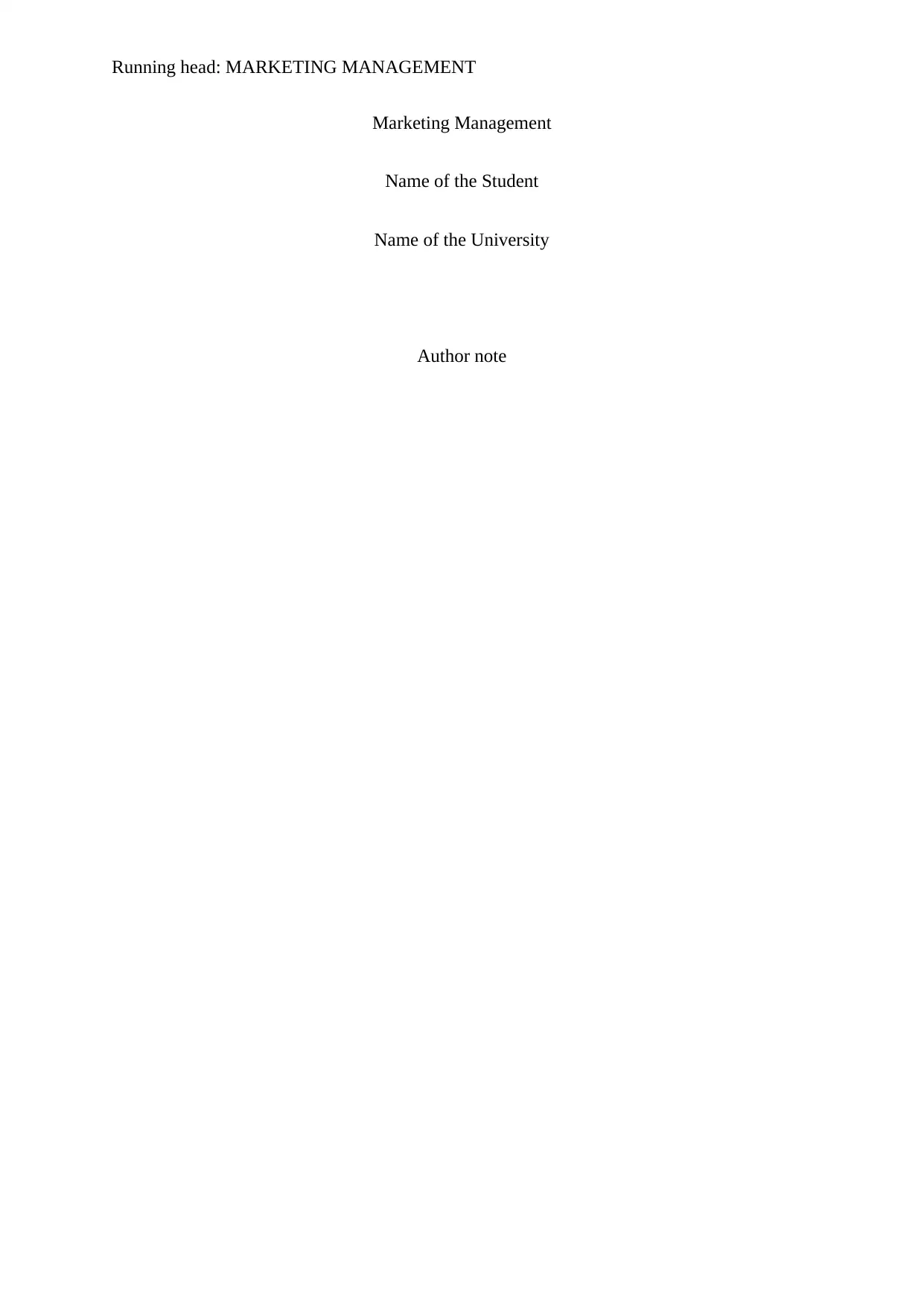
Running head: MARKETING MANAGEMENT
Marketing Management
Name of the Student
Name of the University
Author note
Marketing Management
Name of the Student
Name of the University
Author note
Paraphrase This Document
Need a fresh take? Get an instant paraphrase of this document with our AI Paraphraser
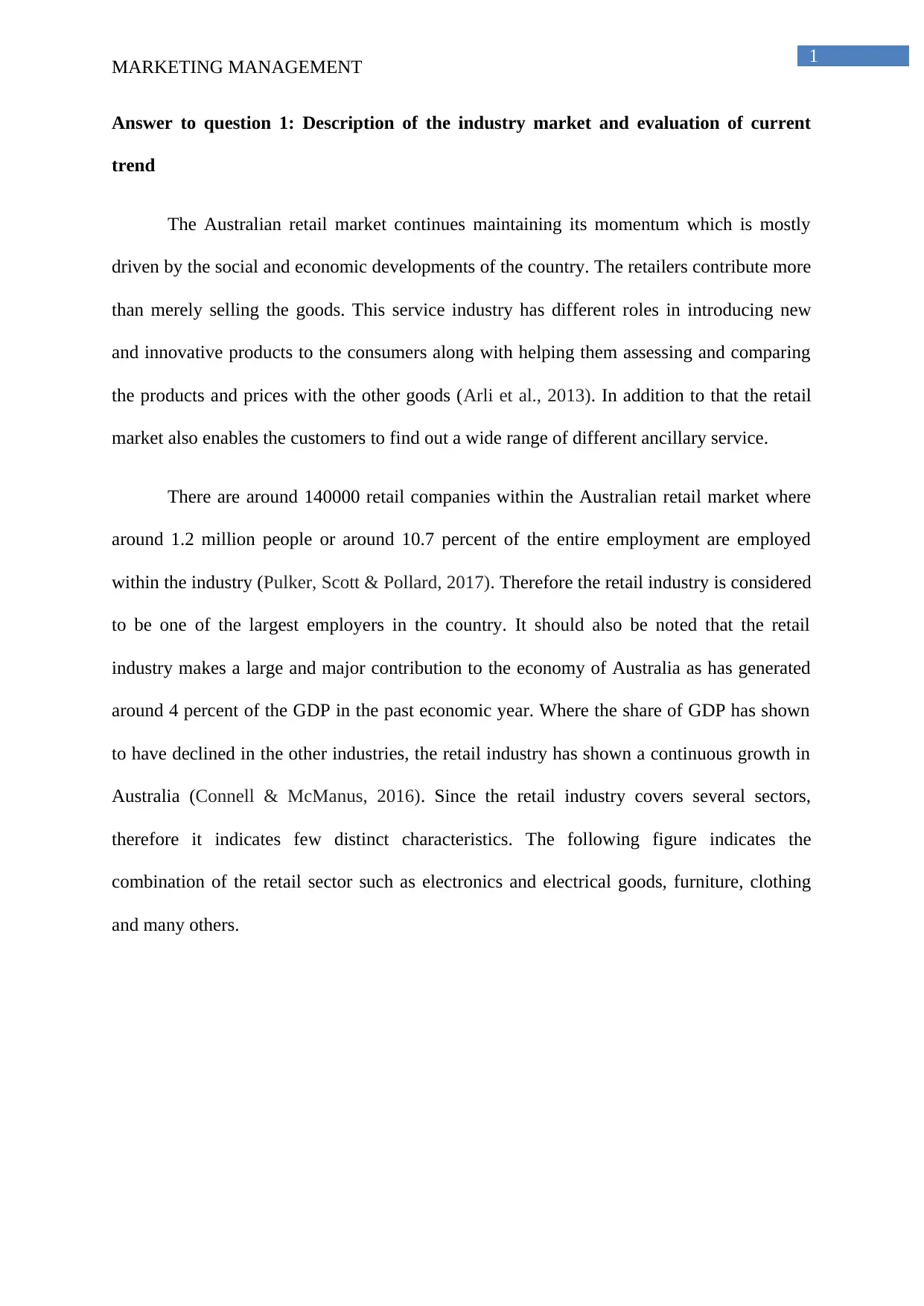
1
MARKETING MANAGEMENT
Answer to question 1: Description of the industry market and evaluation of current
trend
The Australian retail market continues maintaining its momentum which is mostly
driven by the social and economic developments of the country. The retailers contribute more
than merely selling the goods. This service industry has different roles in introducing new
and innovative products to the consumers along with helping them assessing and comparing
the products and prices with the other goods (Arli et al., 2013). In addition to that the retail
market also enables the customers to find out a wide range of different ancillary service.
There are around 140000 retail companies within the Australian retail market where
around 1.2 million people or around 10.7 percent of the entire employment are employed
within the industry (Pulker, Scott & Pollard, 2017). Therefore the retail industry is considered
to be one of the largest employers in the country. It should also be noted that the retail
industry makes a large and major contribution to the economy of Australia as has generated
around 4 percent of the GDP in the past economic year. Where the share of GDP has shown
to have declined in the other industries, the retail industry has shown a continuous growth in
Australia (Connell & McManus, 2016). Since the retail industry covers several sectors,
therefore it indicates few distinct characteristics. The following figure indicates the
combination of the retail sector such as electronics and electrical goods, furniture, clothing
and many others.
MARKETING MANAGEMENT
Answer to question 1: Description of the industry market and evaluation of current
trend
The Australian retail market continues maintaining its momentum which is mostly
driven by the social and economic developments of the country. The retailers contribute more
than merely selling the goods. This service industry has different roles in introducing new
and innovative products to the consumers along with helping them assessing and comparing
the products and prices with the other goods (Arli et al., 2013). In addition to that the retail
market also enables the customers to find out a wide range of different ancillary service.
There are around 140000 retail companies within the Australian retail market where
around 1.2 million people or around 10.7 percent of the entire employment are employed
within the industry (Pulker, Scott & Pollard, 2017). Therefore the retail industry is considered
to be one of the largest employers in the country. It should also be noted that the retail
industry makes a large and major contribution to the economy of Australia as has generated
around 4 percent of the GDP in the past economic year. Where the share of GDP has shown
to have declined in the other industries, the retail industry has shown a continuous growth in
Australia (Connell & McManus, 2016). Since the retail industry covers several sectors,
therefore it indicates few distinct characteristics. The following figure indicates the
combination of the retail sector such as electronics and electrical goods, furniture, clothing
and many others.
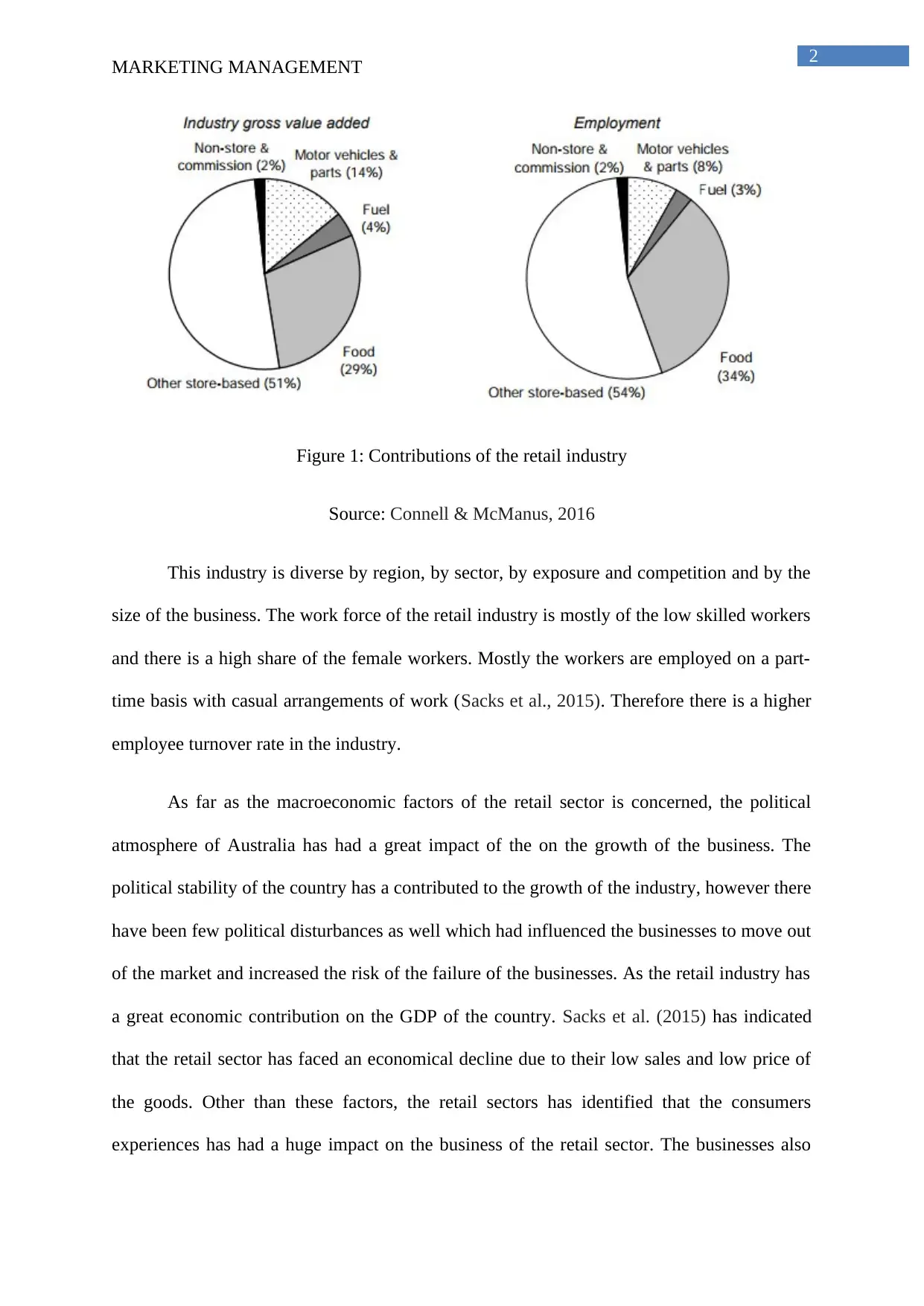
2
MARKETING MANAGEMENT
Figure 1: Contributions of the retail industry
Source: Connell & McManus, 2016
This industry is diverse by region, by sector, by exposure and competition and by the
size of the business. The work force of the retail industry is mostly of the low skilled workers
and there is a high share of the female workers. Mostly the workers are employed on a part-
time basis with casual arrangements of work (Sacks et al., 2015). Therefore there is a higher
employee turnover rate in the industry.
As far as the macroeconomic factors of the retail sector is concerned, the political
atmosphere of Australia has had a great impact of the on the growth of the business. The
political stability of the country has a contributed to the growth of the industry, however there
have been few political disturbances as well which had influenced the businesses to move out
of the market and increased the risk of the failure of the businesses. As the retail industry has
a great economic contribution on the GDP of the country. Sacks et al. (2015) has indicated
that the retail sector has faced an economical decline due to their low sales and low price of
the goods. Other than these factors, the retail sectors has identified that the consumers
experiences has had a huge impact on the business of the retail sector. The businesses also
MARKETING MANAGEMENT
Figure 1: Contributions of the retail industry
Source: Connell & McManus, 2016
This industry is diverse by region, by sector, by exposure and competition and by the
size of the business. The work force of the retail industry is mostly of the low skilled workers
and there is a high share of the female workers. Mostly the workers are employed on a part-
time basis with casual arrangements of work (Sacks et al., 2015). Therefore there is a higher
employee turnover rate in the industry.
As far as the macroeconomic factors of the retail sector is concerned, the political
atmosphere of Australia has had a great impact of the on the growth of the business. The
political stability of the country has a contributed to the growth of the industry, however there
have been few political disturbances as well which had influenced the businesses to move out
of the market and increased the risk of the failure of the businesses. As the retail industry has
a great economic contribution on the GDP of the country. Sacks et al. (2015) has indicated
that the retail sector has faced an economical decline due to their low sales and low price of
the goods. Other than these factors, the retail sectors has identified that the consumers
experiences has had a huge impact on the business of the retail sector. The businesses also
⊘ This is a preview!⊘
Do you want full access?
Subscribe today to unlock all pages.

Trusted by 1+ million students worldwide
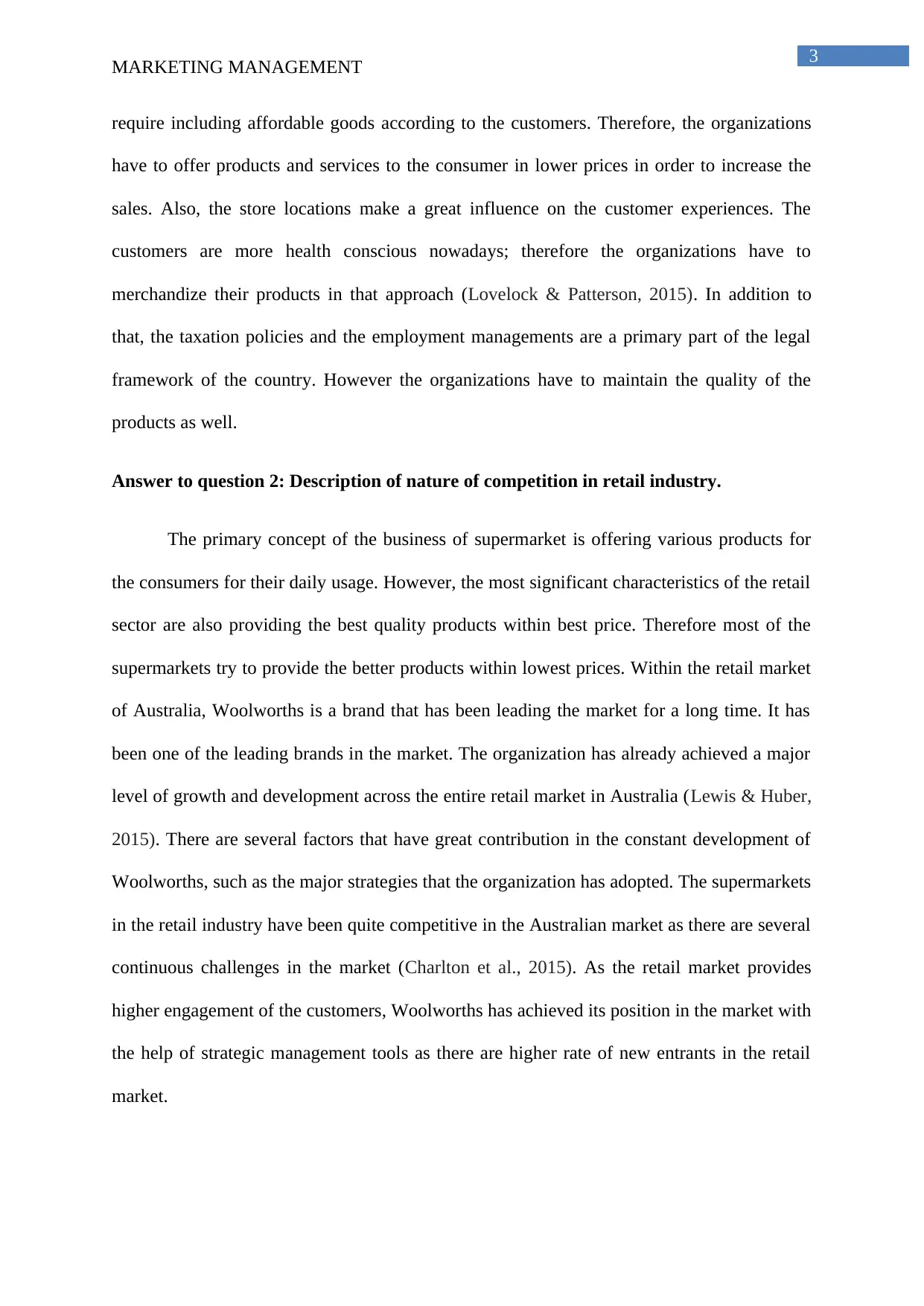
3
MARKETING MANAGEMENT
require including affordable goods according to the customers. Therefore, the organizations
have to offer products and services to the consumer in lower prices in order to increase the
sales. Also, the store locations make a great influence on the customer experiences. The
customers are more health conscious nowadays; therefore the organizations have to
merchandize their products in that approach (Lovelock & Patterson, 2015). In addition to
that, the taxation policies and the employment managements are a primary part of the legal
framework of the country. However the organizations have to maintain the quality of the
products as well.
Answer to question 2: Description of nature of competition in retail industry.
The primary concept of the business of supermarket is offering various products for
the consumers for their daily usage. However, the most significant characteristics of the retail
sector are also providing the best quality products within best price. Therefore most of the
supermarkets try to provide the better products within lowest prices. Within the retail market
of Australia, Woolworths is a brand that has been leading the market for a long time. It has
been one of the leading brands in the market. The organization has already achieved a major
level of growth and development across the entire retail market in Australia (Lewis & Huber,
2015). There are several factors that have great contribution in the constant development of
Woolworths, such as the major strategies that the organization has adopted. The supermarkets
in the retail industry have been quite competitive in the Australian market as there are several
continuous challenges in the market (Charlton et al., 2015). As the retail market provides
higher engagement of the customers, Woolworths has achieved its position in the market with
the help of strategic management tools as there are higher rate of new entrants in the retail
market.
MARKETING MANAGEMENT
require including affordable goods according to the customers. Therefore, the organizations
have to offer products and services to the consumer in lower prices in order to increase the
sales. Also, the store locations make a great influence on the customer experiences. The
customers are more health conscious nowadays; therefore the organizations have to
merchandize their products in that approach (Lovelock & Patterson, 2015). In addition to
that, the taxation policies and the employment managements are a primary part of the legal
framework of the country. However the organizations have to maintain the quality of the
products as well.
Answer to question 2: Description of nature of competition in retail industry.
The primary concept of the business of supermarket is offering various products for
the consumers for their daily usage. However, the most significant characteristics of the retail
sector are also providing the best quality products within best price. Therefore most of the
supermarkets try to provide the better products within lowest prices. Within the retail market
of Australia, Woolworths is a brand that has been leading the market for a long time. It has
been one of the leading brands in the market. The organization has already achieved a major
level of growth and development across the entire retail market in Australia (Lewis & Huber,
2015). There are several factors that have great contribution in the constant development of
Woolworths, such as the major strategies that the organization has adopted. The supermarkets
in the retail industry have been quite competitive in the Australian market as there are several
continuous challenges in the market (Charlton et al., 2015). As the retail market provides
higher engagement of the customers, Woolworths has achieved its position in the market with
the help of strategic management tools as there are higher rate of new entrants in the retail
market.
Paraphrase This Document
Need a fresh take? Get an instant paraphrase of this document with our AI Paraphraser

4
MARKETING MANAGEMENT
Other than the new entrants, there are other competitors of Woolworths in the market
such as Aldi and Coles group. From a long time, Woolworths has been identified as the
strongest leader in the market, however Coles group has been the biggest challenge of the
market. In addition to that, Aldi has also become a challenge to the brand as it offers lowest
price to the consumers as a German food chain. Coles group has occupied around eighty per
cent of the market, where Woolworths has been the greatest competitor of the brand. Coles
has also offered lower prices for its products and services in order to reach the leadership.
Coles has around 700 outlets all across the country, where Woolworths has over 870 stores
all around Australia (Charlton et al., 2015). Both the brands have shared around 80 per cent
of the market; however Aldi has been a big challenge for both the brands. Woolworths has
also created own brands of the organization such as ‘Select’ and ‘Home Brand’. Aldi has
been a great challenge for Woolworths as the brand has a great market presence with around
374 stores all around the country. The origin of the supermarket is in Germany; however the
brand still has a great presence in the international market such as in Australia, UK, Denmark
and France. Both the companies, Coles and Woolworths have applied different strategies for
attracting the consumers towards them. Woolworths has implemented different reward cards,
flyer points and several other loyalty programs which has a great impact of their consumer
loyalty. However, Coles has occupied the leading position in terms of online shopping of the
clients. However, later Woolworths has also followed the similar strategy as Coles and
scrapped the extra charges for the online shopping purpose. According to Chan (2015), the
price difference of three of these brands are not much, as the difference vary from $114 in
Coles, where Woolworths charge $113 and Aldi charge $87. Both the Coles and Woolworths
have implemented same strategies and concentrated of the freshness and variety of the
vegetables and fruits where Aldi has a different strategy of offering less cost for the products.
Brand Characteristics
MARKETING MANAGEMENT
Other than the new entrants, there are other competitors of Woolworths in the market
such as Aldi and Coles group. From a long time, Woolworths has been identified as the
strongest leader in the market, however Coles group has been the biggest challenge of the
market. In addition to that, Aldi has also become a challenge to the brand as it offers lowest
price to the consumers as a German food chain. Coles group has occupied around eighty per
cent of the market, where Woolworths has been the greatest competitor of the brand. Coles
has also offered lower prices for its products and services in order to reach the leadership.
Coles has around 700 outlets all across the country, where Woolworths has over 870 stores
all around Australia (Charlton et al., 2015). Both the brands have shared around 80 per cent
of the market; however Aldi has been a big challenge for both the brands. Woolworths has
also created own brands of the organization such as ‘Select’ and ‘Home Brand’. Aldi has
been a great challenge for Woolworths as the brand has a great market presence with around
374 stores all around the country. The origin of the supermarket is in Germany; however the
brand still has a great presence in the international market such as in Australia, UK, Denmark
and France. Both the companies, Coles and Woolworths have applied different strategies for
attracting the consumers towards them. Woolworths has implemented different reward cards,
flyer points and several other loyalty programs which has a great impact of their consumer
loyalty. However, Coles has occupied the leading position in terms of online shopping of the
clients. However, later Woolworths has also followed the similar strategy as Coles and
scrapped the extra charges for the online shopping purpose. According to Chan (2015), the
price difference of three of these brands are not much, as the difference vary from $114 in
Coles, where Woolworths charge $113 and Aldi charge $87. Both the Coles and Woolworths
have implemented same strategies and concentrated of the freshness and variety of the
vegetables and fruits where Aldi has a different strategy of offering less cost for the products.
Brand Characteristics
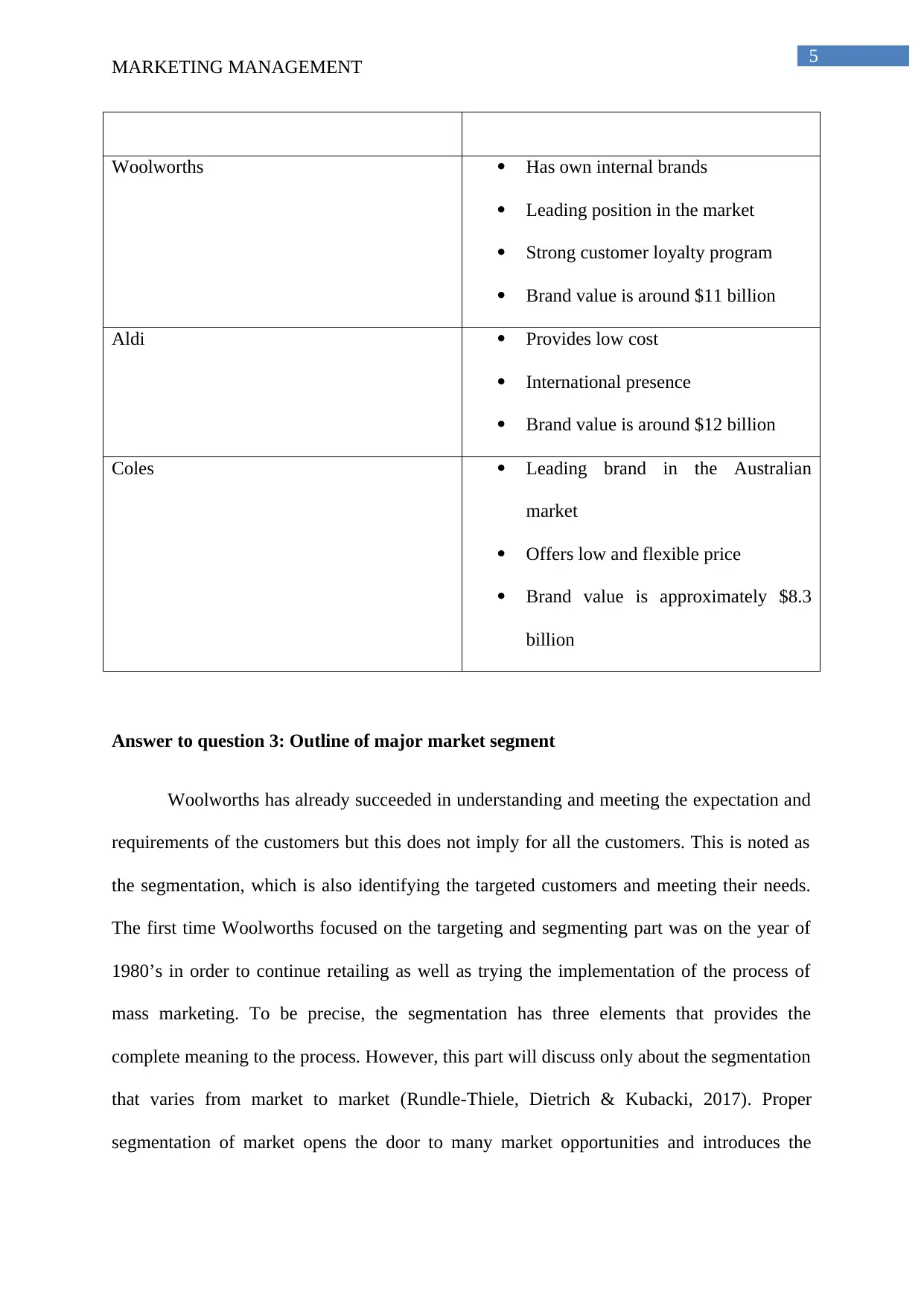
5
MARKETING MANAGEMENT
Woolworths Has own internal brands
Leading position in the market
Strong customer loyalty program
Brand value is around $11 billion
Aldi Provides low cost
International presence
Brand value is around $12 billion
Coles Leading brand in the Australian
market
Offers low and flexible price
Brand value is approximately $8.3
billion
Answer to question 3: Outline of major market segment
Woolworths has already succeeded in understanding and meeting the expectation and
requirements of the customers but this does not imply for all the customers. This is noted as
the segmentation, which is also identifying the targeted customers and meeting their needs.
The first time Woolworths focused on the targeting and segmenting part was on the year of
1980’s in order to continue retailing as well as trying the implementation of the process of
mass marketing. To be precise, the segmentation has three elements that provides the
complete meaning to the process. However, this part will discuss only about the segmentation
that varies from market to market (Rundle-Thiele, Dietrich & Kubacki, 2017). Proper
segmentation of market opens the door to many market opportunities and introduces the
MARKETING MANAGEMENT
Woolworths Has own internal brands
Leading position in the market
Strong customer loyalty program
Brand value is around $11 billion
Aldi Provides low cost
International presence
Brand value is around $12 billion
Coles Leading brand in the Australian
market
Offers low and flexible price
Brand value is approximately $8.3
billion
Answer to question 3: Outline of major market segment
Woolworths has already succeeded in understanding and meeting the expectation and
requirements of the customers but this does not imply for all the customers. This is noted as
the segmentation, which is also identifying the targeted customers and meeting their needs.
The first time Woolworths focused on the targeting and segmenting part was on the year of
1980’s in order to continue retailing as well as trying the implementation of the process of
mass marketing. To be precise, the segmentation has three elements that provides the
complete meaning to the process. However, this part will discuss only about the segmentation
that varies from market to market (Rundle-Thiele, Dietrich & Kubacki, 2017). Proper
segmentation of market opens the door to many market opportunities and introduces the
⊘ This is a preview!⊘
Do you want full access?
Subscribe today to unlock all pages.

Trusted by 1+ million students worldwide
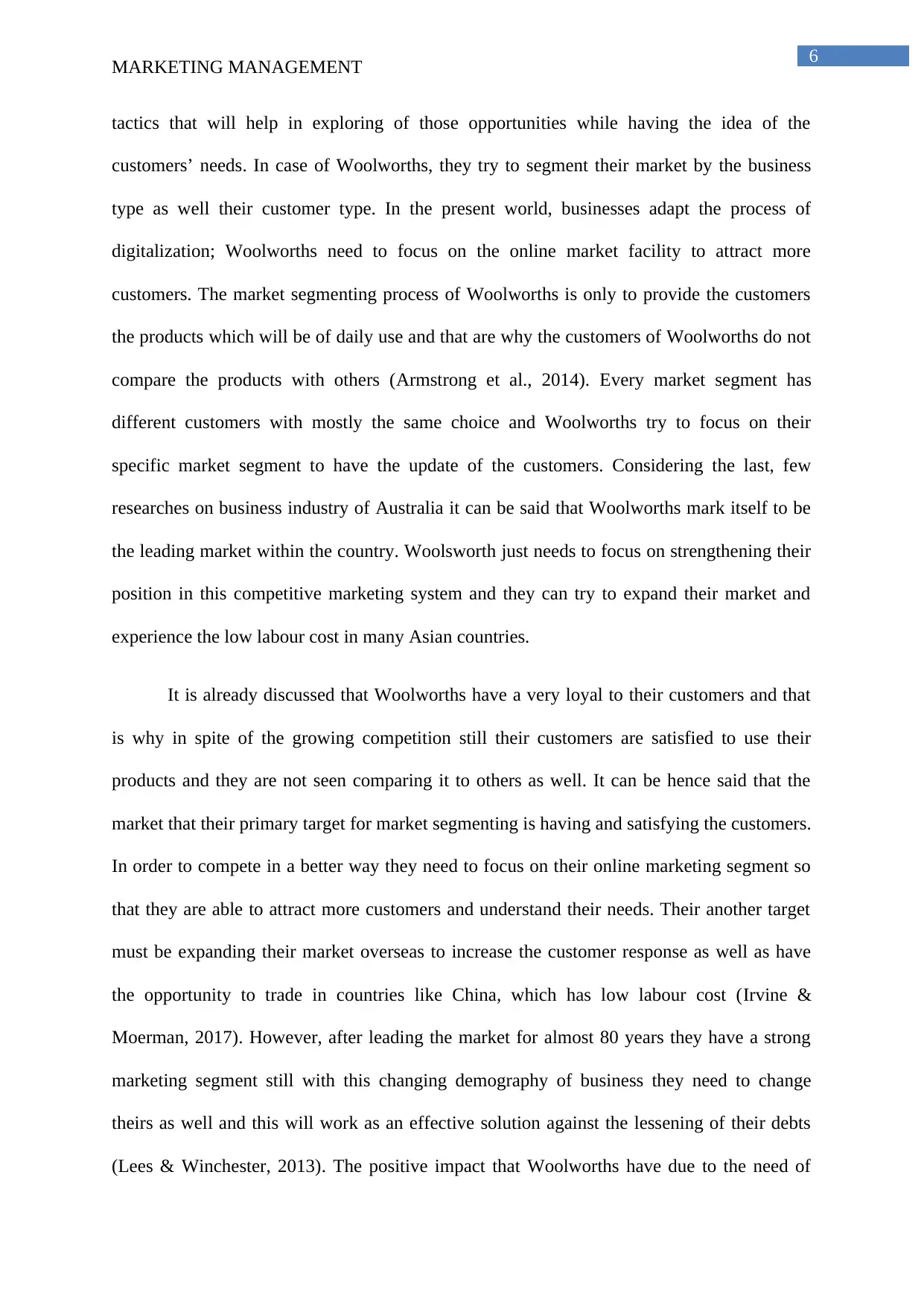
6
MARKETING MANAGEMENT
tactics that will help in exploring of those opportunities while having the idea of the
customers’ needs. In case of Woolworths, they try to segment their market by the business
type as well their customer type. In the present world, businesses adapt the process of
digitalization; Woolworths need to focus on the online market facility to attract more
customers. The market segmenting process of Woolworths is only to provide the customers
the products which will be of daily use and that are why the customers of Woolworths do not
compare the products with others (Armstrong et al., 2014). Every market segment has
different customers with mostly the same choice and Woolworths try to focus on their
specific market segment to have the update of the customers. Considering the last, few
researches on business industry of Australia it can be said that Woolworths mark itself to be
the leading market within the country. Woolsworth just needs to focus on strengthening their
position in this competitive marketing system and they can try to expand their market and
experience the low labour cost in many Asian countries.
It is already discussed that Woolworths have a very loyal to their customers and that
is why in spite of the growing competition still their customers are satisfied to use their
products and they are not seen comparing it to others as well. It can be hence said that the
market that their primary target for market segmenting is having and satisfying the customers.
In order to compete in a better way they need to focus on their online marketing segment so
that they are able to attract more customers and understand their needs. Their another target
must be expanding their market overseas to increase the customer response as well as have
the opportunity to trade in countries like China, which has low labour cost (Irvine &
Moerman, 2017). However, after leading the market for almost 80 years they have a strong
marketing segment still with this changing demography of business they need to change
theirs as well and this will work as an effective solution against the lessening of their debts
(Lees & Winchester, 2013). The positive impact that Woolworths have due to the need of
MARKETING MANAGEMENT
tactics that will help in exploring of those opportunities while having the idea of the
customers’ needs. In case of Woolworths, they try to segment their market by the business
type as well their customer type. In the present world, businesses adapt the process of
digitalization; Woolworths need to focus on the online market facility to attract more
customers. The market segmenting process of Woolworths is only to provide the customers
the products which will be of daily use and that are why the customers of Woolworths do not
compare the products with others (Armstrong et al., 2014). Every market segment has
different customers with mostly the same choice and Woolworths try to focus on their
specific market segment to have the update of the customers. Considering the last, few
researches on business industry of Australia it can be said that Woolworths mark itself to be
the leading market within the country. Woolsworth just needs to focus on strengthening their
position in this competitive marketing system and they can try to expand their market and
experience the low labour cost in many Asian countries.
It is already discussed that Woolworths have a very loyal to their customers and that
is why in spite of the growing competition still their customers are satisfied to use their
products and they are not seen comparing it to others as well. It can be hence said that the
market that their primary target for market segmenting is having and satisfying the customers.
In order to compete in a better way they need to focus on their online marketing segment so
that they are able to attract more customers and understand their needs. Their another target
must be expanding their market overseas to increase the customer response as well as have
the opportunity to trade in countries like China, which has low labour cost (Irvine &
Moerman, 2017). However, after leading the market for almost 80 years they have a strong
marketing segment still with this changing demography of business they need to change
theirs as well and this will work as an effective solution against the lessening of their debts
(Lees & Winchester, 2013). The positive impact that Woolworths have due to the need of
Paraphrase This Document
Need a fresh take? Get an instant paraphrase of this document with our AI Paraphraser
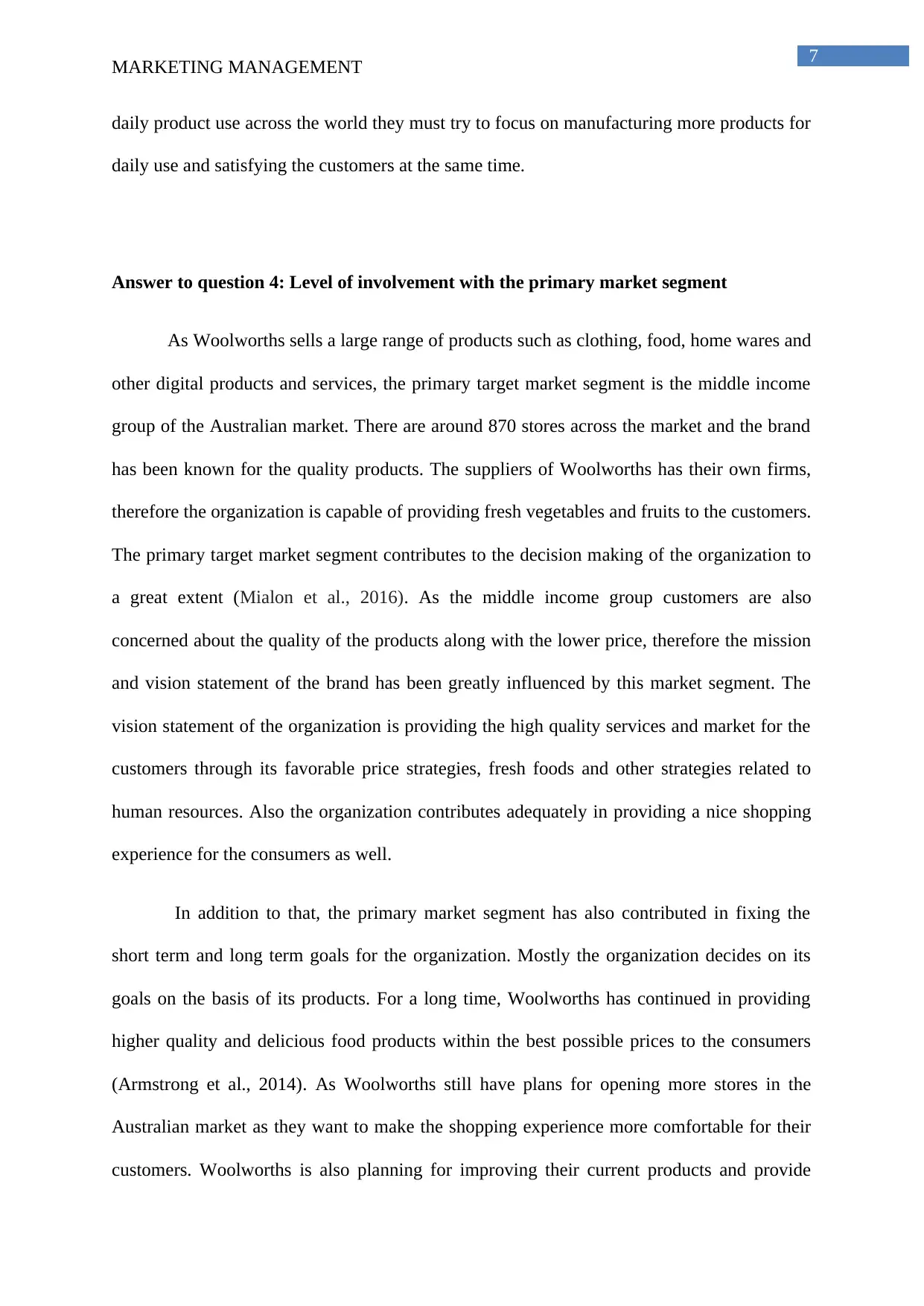
7
MARKETING MANAGEMENT
daily product use across the world they must try to focus on manufacturing more products for
daily use and satisfying the customers at the same time.
Answer to question 4: Level of involvement with the primary market segment
As Woolworths sells a large range of products such as clothing, food, home wares and
other digital products and services, the primary target market segment is the middle income
group of the Australian market. There are around 870 stores across the market and the brand
has been known for the quality products. The suppliers of Woolworths has their own firms,
therefore the organization is capable of providing fresh vegetables and fruits to the customers.
The primary target market segment contributes to the decision making of the organization to
a great extent (Mialon et al., 2016). As the middle income group customers are also
concerned about the quality of the products along with the lower price, therefore the mission
and vision statement of the brand has been greatly influenced by this market segment. The
vision statement of the organization is providing the high quality services and market for the
customers through its favorable price strategies, fresh foods and other strategies related to
human resources. Also the organization contributes adequately in providing a nice shopping
experience for the consumers as well.
In addition to that, the primary market segment has also contributed in fixing the
short term and long term goals for the organization. Mostly the organization decides on its
goals on the basis of its products. For a long time, Woolworths has continued in providing
higher quality and delicious food products within the best possible prices to the consumers
(Armstrong et al., 2014). As Woolworths still have plans for opening more stores in the
Australian market as they want to make the shopping experience more comfortable for their
customers. Woolworths is also planning for improving their current products and provide
MARKETING MANAGEMENT
daily product use across the world they must try to focus on manufacturing more products for
daily use and satisfying the customers at the same time.
Answer to question 4: Level of involvement with the primary market segment
As Woolworths sells a large range of products such as clothing, food, home wares and
other digital products and services, the primary target market segment is the middle income
group of the Australian market. There are around 870 stores across the market and the brand
has been known for the quality products. The suppliers of Woolworths has their own firms,
therefore the organization is capable of providing fresh vegetables and fruits to the customers.
The primary target market segment contributes to the decision making of the organization to
a great extent (Mialon et al., 2016). As the middle income group customers are also
concerned about the quality of the products along with the lower price, therefore the mission
and vision statement of the brand has been greatly influenced by this market segment. The
vision statement of the organization is providing the high quality services and market for the
customers through its favorable price strategies, fresh foods and other strategies related to
human resources. Also the organization contributes adequately in providing a nice shopping
experience for the consumers as well.
In addition to that, the primary market segment has also contributed in fixing the
short term and long term goals for the organization. Mostly the organization decides on its
goals on the basis of its products. For a long time, Woolworths has continued in providing
higher quality and delicious food products within the best possible prices to the consumers
(Armstrong et al., 2014). As Woolworths still have plans for opening more stores in the
Australian market as they want to make the shopping experience more comfortable for their
customers. Woolworths is also planning for improving their current products and provide
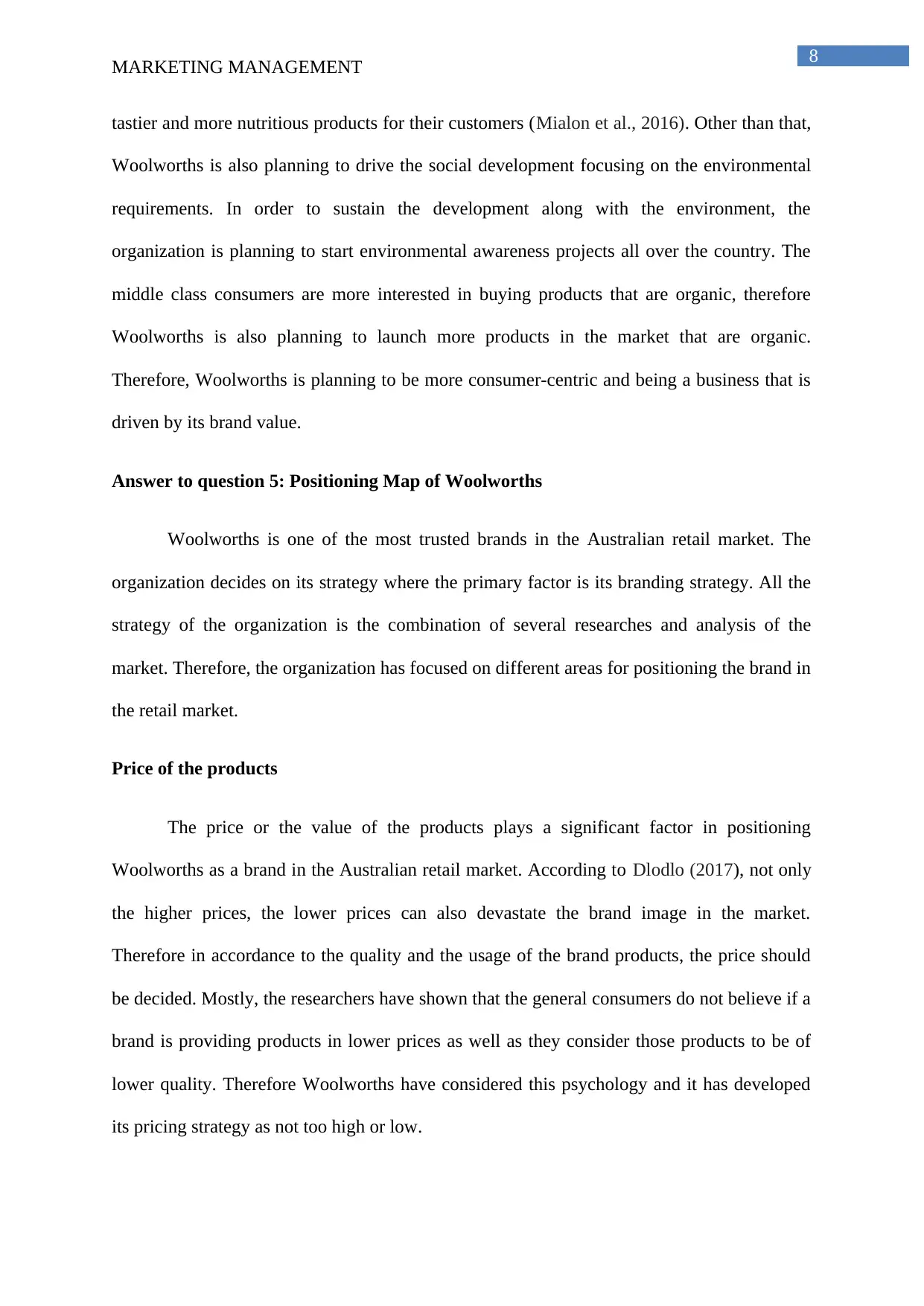
8
MARKETING MANAGEMENT
tastier and more nutritious products for their customers (Mialon et al., 2016). Other than that,
Woolworths is also planning to drive the social development focusing on the environmental
requirements. In order to sustain the development along with the environment, the
organization is planning to start environmental awareness projects all over the country. The
middle class consumers are more interested in buying products that are organic, therefore
Woolworths is also planning to launch more products in the market that are organic.
Therefore, Woolworths is planning to be more consumer-centric and being a business that is
driven by its brand value.
Answer to question 5: Positioning Map of Woolworths
Woolworths is one of the most trusted brands in the Australian retail market. The
organization decides on its strategy where the primary factor is its branding strategy. All the
strategy of the organization is the combination of several researches and analysis of the
market. Therefore, the organization has focused on different areas for positioning the brand in
the retail market.
Price of the products
The price or the value of the products plays a significant factor in positioning
Woolworths as a brand in the Australian retail market. According to Dlodlo (2017), not only
the higher prices, the lower prices can also devastate the brand image in the market.
Therefore in accordance to the quality and the usage of the brand products, the price should
be decided. Mostly, the researchers have shown that the general consumers do not believe if a
brand is providing products in lower prices as well as they consider those products to be of
lower quality. Therefore Woolworths have considered this psychology and it has developed
its pricing strategy as not too high or low.
MARKETING MANAGEMENT
tastier and more nutritious products for their customers (Mialon et al., 2016). Other than that,
Woolworths is also planning to drive the social development focusing on the environmental
requirements. In order to sustain the development along with the environment, the
organization is planning to start environmental awareness projects all over the country. The
middle class consumers are more interested in buying products that are organic, therefore
Woolworths is also planning to launch more products in the market that are organic.
Therefore, Woolworths is planning to be more consumer-centric and being a business that is
driven by its brand value.
Answer to question 5: Positioning Map of Woolworths
Woolworths is one of the most trusted brands in the Australian retail market. The
organization decides on its strategy where the primary factor is its branding strategy. All the
strategy of the organization is the combination of several researches and analysis of the
market. Therefore, the organization has focused on different areas for positioning the brand in
the retail market.
Price of the products
The price or the value of the products plays a significant factor in positioning
Woolworths as a brand in the Australian retail market. According to Dlodlo (2017), not only
the higher prices, the lower prices can also devastate the brand image in the market.
Therefore in accordance to the quality and the usage of the brand products, the price should
be decided. Mostly, the researchers have shown that the general consumers do not believe if a
brand is providing products in lower prices as well as they consider those products to be of
lower quality. Therefore Woolworths have considered this psychology and it has developed
its pricing strategy as not too high or low.
⊘ This is a preview!⊘
Do you want full access?
Subscribe today to unlock all pages.

Trusted by 1+ million students worldwide
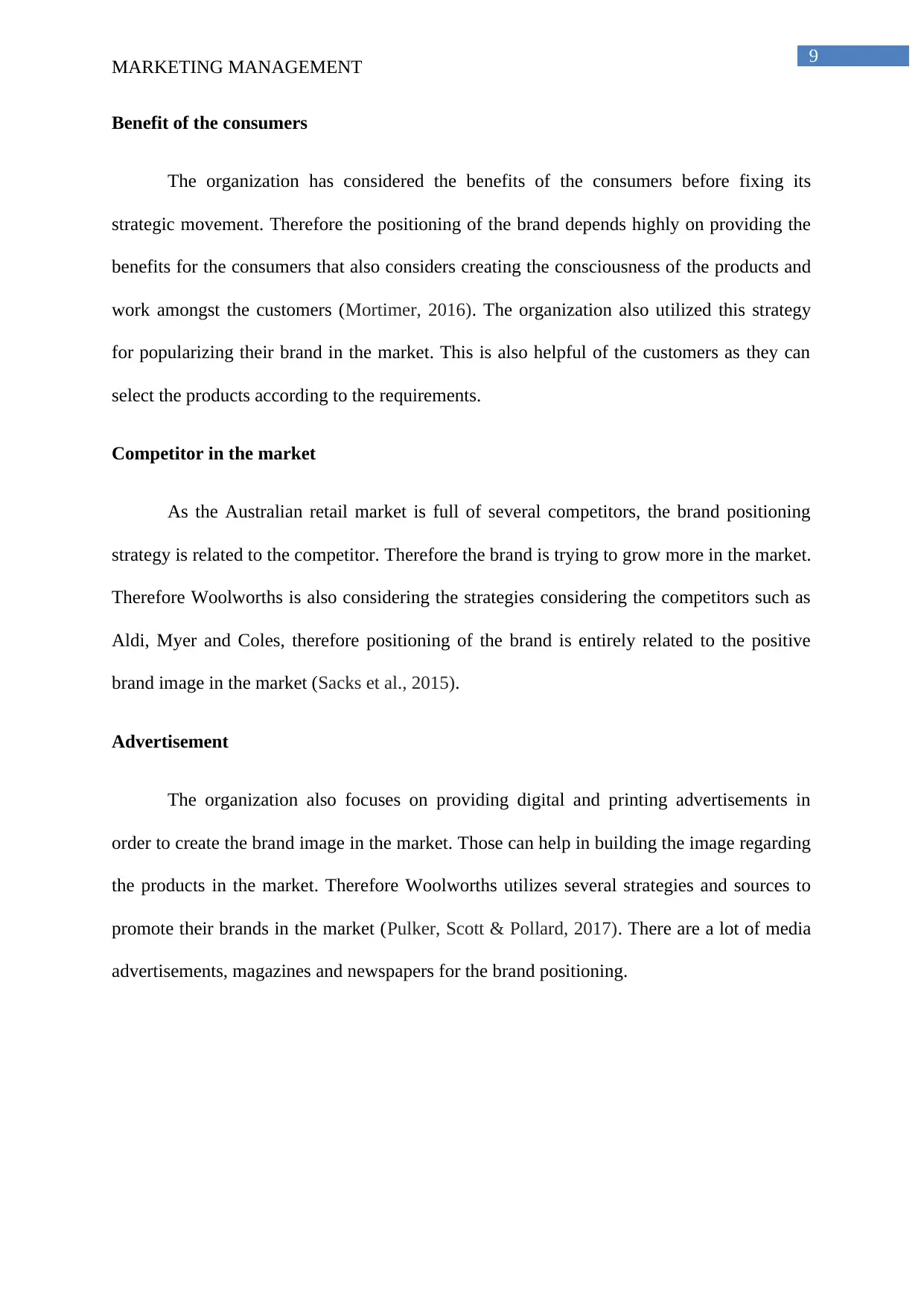
9
MARKETING MANAGEMENT
Benefit of the consumers
The organization has considered the benefits of the consumers before fixing its
strategic movement. Therefore the positioning of the brand depends highly on providing the
benefits for the consumers that also considers creating the consciousness of the products and
work amongst the customers (Mortimer, 2016). The organization also utilized this strategy
for popularizing their brand in the market. This is also helpful of the customers as they can
select the products according to the requirements.
Competitor in the market
As the Australian retail market is full of several competitors, the brand positioning
strategy is related to the competitor. Therefore the brand is trying to grow more in the market.
Therefore Woolworths is also considering the strategies considering the competitors such as
Aldi, Myer and Coles, therefore positioning of the brand is entirely related to the positive
brand image in the market (Sacks et al., 2015).
Advertisement
The organization also focuses on providing digital and printing advertisements in
order to create the brand image in the market. Those can help in building the image regarding
the products in the market. Therefore Woolworths utilizes several strategies and sources to
promote their brands in the market (Pulker, Scott & Pollard, 2017). There are a lot of media
advertisements, magazines and newspapers for the brand positioning.
MARKETING MANAGEMENT
Benefit of the consumers
The organization has considered the benefits of the consumers before fixing its
strategic movement. Therefore the positioning of the brand depends highly on providing the
benefits for the consumers that also considers creating the consciousness of the products and
work amongst the customers (Mortimer, 2016). The organization also utilized this strategy
for popularizing their brand in the market. This is also helpful of the customers as they can
select the products according to the requirements.
Competitor in the market
As the Australian retail market is full of several competitors, the brand positioning
strategy is related to the competitor. Therefore the brand is trying to grow more in the market.
Therefore Woolworths is also considering the strategies considering the competitors such as
Aldi, Myer and Coles, therefore positioning of the brand is entirely related to the positive
brand image in the market (Sacks et al., 2015).
Advertisement
The organization also focuses on providing digital and printing advertisements in
order to create the brand image in the market. Those can help in building the image regarding
the products in the market. Therefore Woolworths utilizes several strategies and sources to
promote their brands in the market (Pulker, Scott & Pollard, 2017). There are a lot of media
advertisements, magazines and newspapers for the brand positioning.
Paraphrase This Document
Need a fresh take? Get an instant paraphrase of this document with our AI Paraphraser
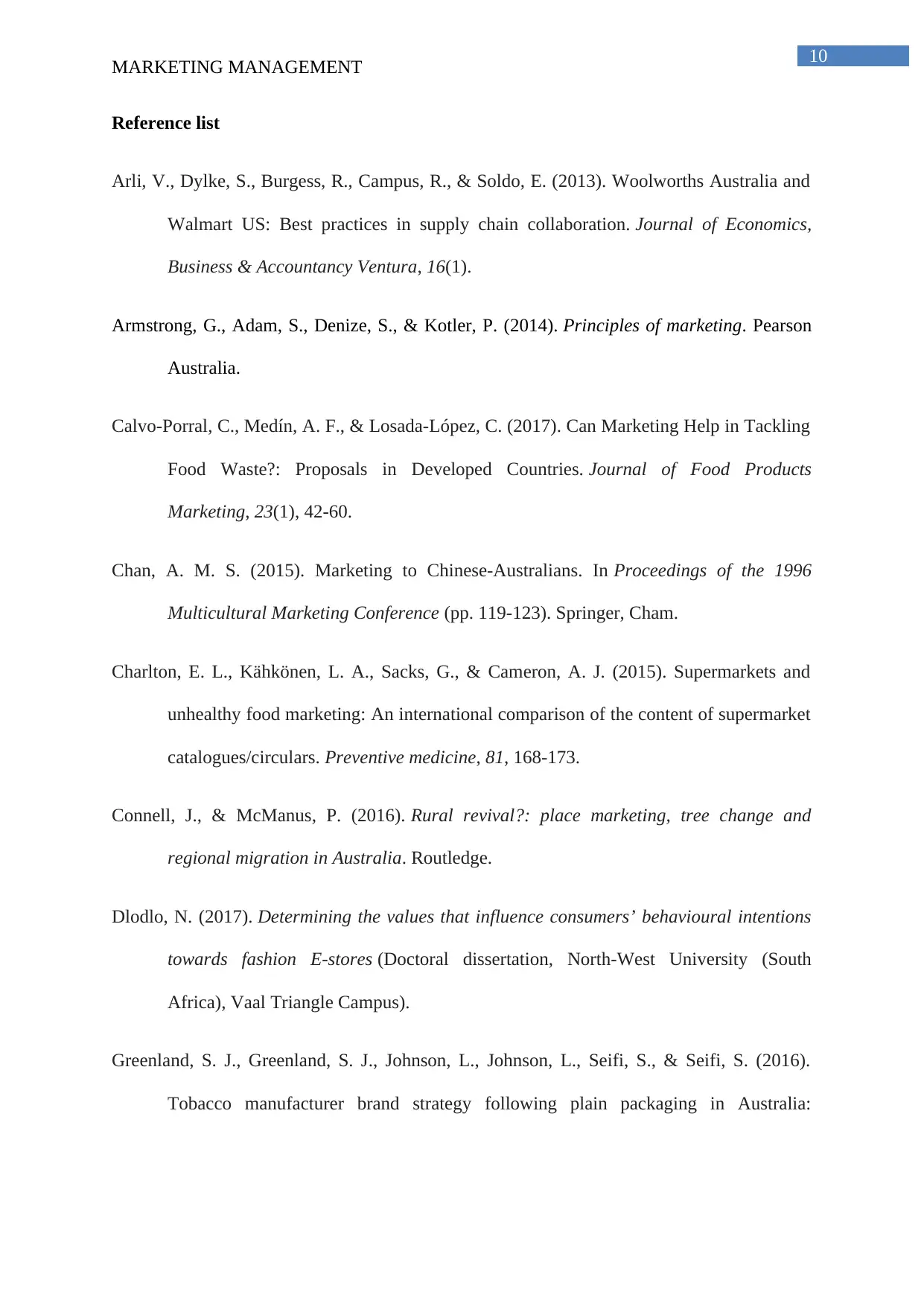
10
MARKETING MANAGEMENT
Reference list
Arli, V., Dylke, S., Burgess, R., Campus, R., & Soldo, E. (2013). Woolworths Australia and
Walmart US: Best practices in supply chain collaboration. Journal of Economics,
Business & Accountancy Ventura, 16(1).
Armstrong, G., Adam, S., Denize, S., & Kotler, P. (2014). Principles of marketing. Pearson
Australia.
Calvo-Porral, C., Medín, A. F., & Losada-López, C. (2017). Can Marketing Help in Tackling
Food Waste?: Proposals in Developed Countries. Journal of Food Products
Marketing, 23(1), 42-60.
Chan, A. M. S. (2015). Marketing to Chinese-Australians. In Proceedings of the 1996
Multicultural Marketing Conference (pp. 119-123). Springer, Cham.
Charlton, E. L., Kähkönen, L. A., Sacks, G., & Cameron, A. J. (2015). Supermarkets and
unhealthy food marketing: An international comparison of the content of supermarket
catalogues/circulars. Preventive medicine, 81, 168-173.
Connell, J., & McManus, P. (2016). Rural revival?: place marketing, tree change and
regional migration in Australia. Routledge.
Dlodlo, N. (2017). Determining the values that influence consumers’ behavioural intentions
towards fashion E-stores (Doctoral dissertation, North-West University (South
Africa), Vaal Triangle Campus).
Greenland, S. J., Greenland, S. J., Johnson, L., Johnson, L., Seifi, S., & Seifi, S. (2016).
Tobacco manufacturer brand strategy following plain packaging in Australia:
MARKETING MANAGEMENT
Reference list
Arli, V., Dylke, S., Burgess, R., Campus, R., & Soldo, E. (2013). Woolworths Australia and
Walmart US: Best practices in supply chain collaboration. Journal of Economics,
Business & Accountancy Ventura, 16(1).
Armstrong, G., Adam, S., Denize, S., & Kotler, P. (2014). Principles of marketing. Pearson
Australia.
Calvo-Porral, C., Medín, A. F., & Losada-López, C. (2017). Can Marketing Help in Tackling
Food Waste?: Proposals in Developed Countries. Journal of Food Products
Marketing, 23(1), 42-60.
Chan, A. M. S. (2015). Marketing to Chinese-Australians. In Proceedings of the 1996
Multicultural Marketing Conference (pp. 119-123). Springer, Cham.
Charlton, E. L., Kähkönen, L. A., Sacks, G., & Cameron, A. J. (2015). Supermarkets and
unhealthy food marketing: An international comparison of the content of supermarket
catalogues/circulars. Preventive medicine, 81, 168-173.
Connell, J., & McManus, P. (2016). Rural revival?: place marketing, tree change and
regional migration in Australia. Routledge.
Dlodlo, N. (2017). Determining the values that influence consumers’ behavioural intentions
towards fashion E-stores (Doctoral dissertation, North-West University (South
Africa), Vaal Triangle Campus).
Greenland, S. J., Greenland, S. J., Johnson, L., Johnson, L., Seifi, S., & Seifi, S. (2016).
Tobacco manufacturer brand strategy following plain packaging in Australia:
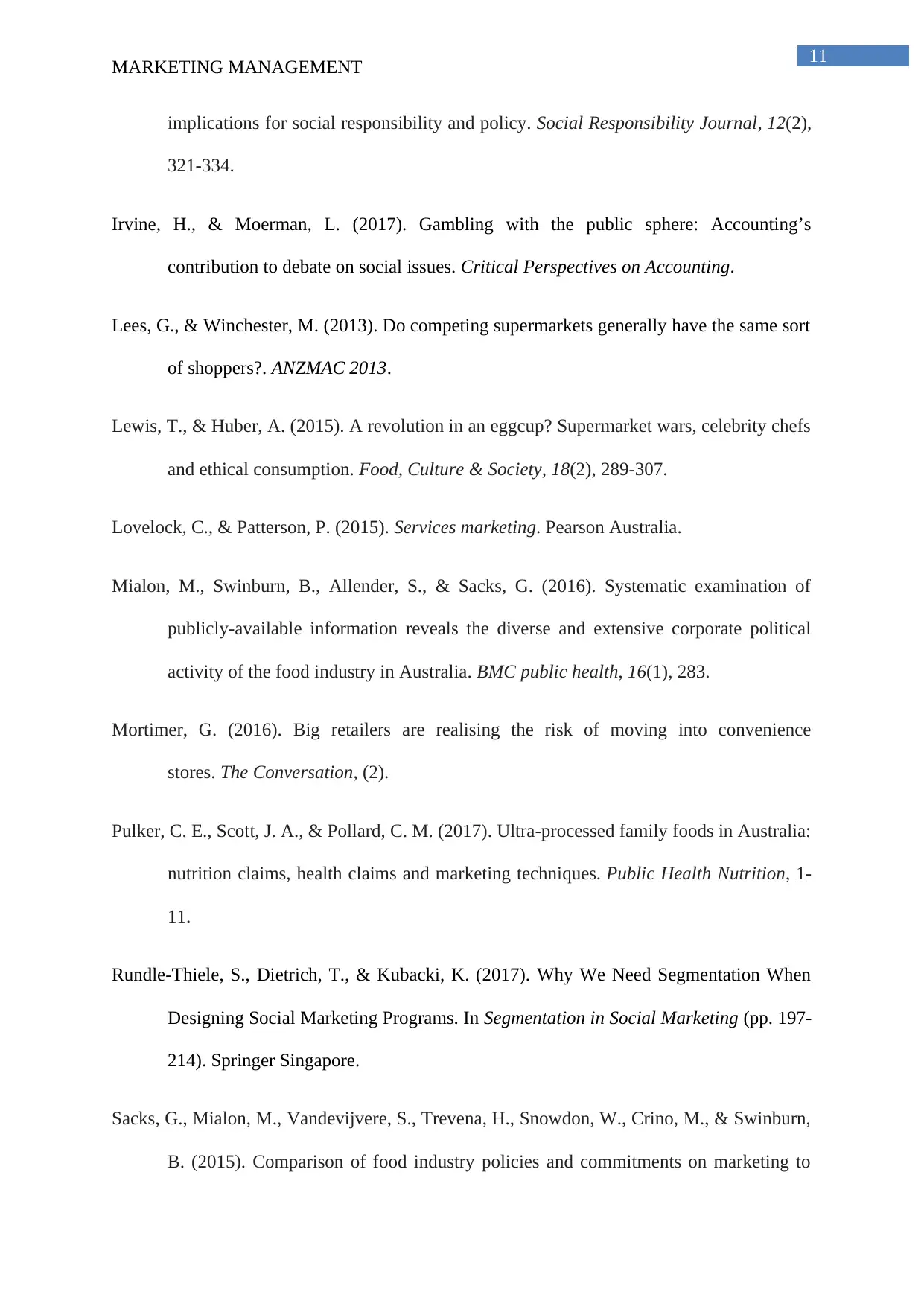
11
MARKETING MANAGEMENT
implications for social responsibility and policy. Social Responsibility Journal, 12(2),
321-334.
Irvine, H., & Moerman, L. (2017). Gambling with the public sphere: Accounting’s
contribution to debate on social issues. Critical Perspectives on Accounting.
Lees, G., & Winchester, M. (2013). Do competing supermarkets generally have the same sort
of shoppers?. ANZMAC 2013.
Lewis, T., & Huber, A. (2015). A revolution in an eggcup? Supermarket wars, celebrity chefs
and ethical consumption. Food, Culture & Society, 18(2), 289-307.
Lovelock, C., & Patterson, P. (2015). Services marketing. Pearson Australia.
Mialon, M., Swinburn, B., Allender, S., & Sacks, G. (2016). Systematic examination of
publicly-available information reveals the diverse and extensive corporate political
activity of the food industry in Australia. BMC public health, 16(1), 283.
Mortimer, G. (2016). Big retailers are realising the risk of moving into convenience
stores. The Conversation, (2).
Pulker, C. E., Scott, J. A., & Pollard, C. M. (2017). Ultra-processed family foods in Australia:
nutrition claims, health claims and marketing techniques. Public Health Nutrition, 1-
11.
Rundle-Thiele, S., Dietrich, T., & Kubacki, K. (2017). Why We Need Segmentation When
Designing Social Marketing Programs. In Segmentation in Social Marketing (pp. 197-
214). Springer Singapore.
Sacks, G., Mialon, M., Vandevijvere, S., Trevena, H., Snowdon, W., Crino, M., & Swinburn,
B. (2015). Comparison of food industry policies and commitments on marketing to
MARKETING MANAGEMENT
implications for social responsibility and policy. Social Responsibility Journal, 12(2),
321-334.
Irvine, H., & Moerman, L. (2017). Gambling with the public sphere: Accounting’s
contribution to debate on social issues. Critical Perspectives on Accounting.
Lees, G., & Winchester, M. (2013). Do competing supermarkets generally have the same sort
of shoppers?. ANZMAC 2013.
Lewis, T., & Huber, A. (2015). A revolution in an eggcup? Supermarket wars, celebrity chefs
and ethical consumption. Food, Culture & Society, 18(2), 289-307.
Lovelock, C., & Patterson, P. (2015). Services marketing. Pearson Australia.
Mialon, M., Swinburn, B., Allender, S., & Sacks, G. (2016). Systematic examination of
publicly-available information reveals the diverse and extensive corporate political
activity of the food industry in Australia. BMC public health, 16(1), 283.
Mortimer, G. (2016). Big retailers are realising the risk of moving into convenience
stores. The Conversation, (2).
Pulker, C. E., Scott, J. A., & Pollard, C. M. (2017). Ultra-processed family foods in Australia:
nutrition claims, health claims and marketing techniques. Public Health Nutrition, 1-
11.
Rundle-Thiele, S., Dietrich, T., & Kubacki, K. (2017). Why We Need Segmentation When
Designing Social Marketing Programs. In Segmentation in Social Marketing (pp. 197-
214). Springer Singapore.
Sacks, G., Mialon, M., Vandevijvere, S., Trevena, H., Snowdon, W., Crino, M., & Swinburn,
B. (2015). Comparison of food industry policies and commitments on marketing to
⊘ This is a preview!⊘
Do you want full access?
Subscribe today to unlock all pages.

Trusted by 1+ million students worldwide
1 out of 13
Related Documents
Your All-in-One AI-Powered Toolkit for Academic Success.
+13062052269
info@desklib.com
Available 24*7 on WhatsApp / Email
![[object Object]](/_next/static/media/star-bottom.7253800d.svg)
Unlock your academic potential
Copyright © 2020–2025 A2Z Services. All Rights Reserved. Developed and managed by ZUCOL.





